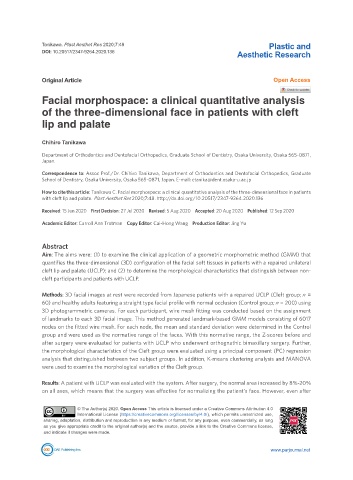Page 547 - Read Online
P. 547
Tanikawa. Plast Aesthet Res 2020;7:48 Plastic and
DOI: 10.20517/2347-9264.2020.136 Aesthetic Research
Original Article Open Access
Facial morphospace: a clinical quantitative analysis
of the three-dimensional face in patients with cleft
lip and palate
Chihiro Tanikawa
Department of Orthodontics and Dentofacial Orthopedics, Graduate School of Dentistry, Osaka University, Osaka 565-0871,
Japan.
Correspondence to: Assoc Prof./Dr. Chihiro Tanikawa, Department of Orthodontics and Dentofacial Orthopedics, Graduate
School of Dentistry, Osaka University, Osaka 565-0871, Japan. E-mail: ctanika@dent.osaka-u.ac.jp
How to cite this article: Tanikawa C. Facial morphospace: a clinical quantitative analysis of the three-dimensional face in patients
with cleft lip and palate. Plast Aesthet Res 2020;7:48. http://dx.doi.org/10.20517/2347-9264.2020.136
Received: 15 Jun 2020 First Decision: 27 Jul 2020 Revised: 5 Aug 2020 Accepted: 20 Aug 2020 Published: 12 Sep 2020
Academic Editor: Carroll Ann Trotman Copy Editor: Cai-Hong Wang Production Editor: Jing Yu
Abstract
Aim: The aims were: (1) to examine the clinical application of a geometric morphometric method (GMM) that
quantifies the three-dimensional (3D) configuration of the facial soft tissues in patients with a repaired unilateral
cleft lip and palate (UCLP); and (2) to determine the morphological characteristics that distinguish between non-
cleft participants and patients with UCLP.
Methods: 3D facial images at rest were recorded from Japanese patients with a repaired UCLP (Cleft group; n =
60) and healthy adults featuring a straight type facial profile with normal occlusion (Control group; n = 200) using
3D photogrammetric cameras. For each participant, wire mesh fitting was conducted based on the assignment
of landmarks to each 3D facial image. This method generated landmark-based GMM models consisting of 6017
nodes on the fitted wire mesh. For each node, the mean and standard deviation were determined in the Control
group and were used as the normative range of the faces. With this normative range, the Z-scores before and
after surgery were evaluated for patients with UCLP who underwent orthognathic bimaxillary surgery. Further,
the morphological characteristics of the Cleft group were evaluated using a principal component (PC) regression
analysis that distinguished between two subject groups. In addition, K-means clustering analysis and MANOVA
were used to examine the morphological variation of the Cleft group.
Results: A patient with UCLP was evaluated with the system. After surgery, the normal area increased by 8%-20%
on all axes, which means that the surgery was effective for normalizing the patient’s face. However, even after
© The Author(s) 2020. Open Access This article is licensed under a Creative Commons Attribution 4.0
International License (https://creativecommons.org/licenses/by/4.0/), which permits unrestricted use,
sharing, adaptation, distribution and reproduction in any medium or format, for any purpose, even commercially, as long
as you give appropriate credit to the original author(s) and the source, provide a link to the Creative Commons license,
and indicate if changes were made.
www.parjournal.net

